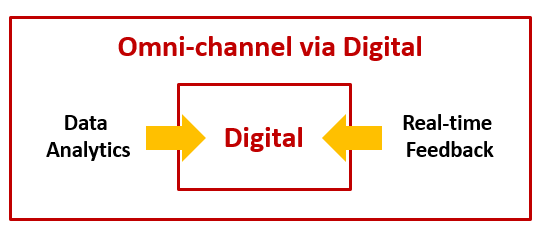It’s a provocative title, but BCG argues the case. Digital is more important than ever; it’s where people spend their attention and advertisers place their dollars. Money is abundant. Attention is in short supply. This digital conversation gives marketers a chance to micro-target and build relationships by testing/learning at scale. Instead of using marketing proxies, marketers can use something better – data. Warning to old-school marketers:
- If you are trying to apply traditional media tactics to digital – bad
- If you are not digitally engaging with your customers – bad
- If you are not marketing with fast-confirmation from analytics – bad
- Y.o.u.m.a.y.b.e.i.n.t.r.o.u.b.l.e.
As Gary Vaynerchuk says [paraphrasing], “Your phone is the remote control for your life.” The average American spends 50min on FB daily. Marketers need to be there – in the pocket and purse.
If you’re a marketer, read the full article here. It’s 3,600 words and an easy read with 3 case studies. Eat your (professional) vegetables.
If not a marketer, 9 major points. Consultants love to simplify things:
1) Digital marketing is getting the $$.
- In 2017, on track to exceed TV spend for the first time (big news)
- Since 2011, mobile spend has 2x annually
- Since 2011, social media up 40-60% annually
2) Digital marketing is fluid and interactive:
- Use consumer data to inform their campaigns; data analytics
- Develop an “omni-relationship” via multiple channels; not just 1 way broadcasting (e.g., TV, billboard); digital is the glue
- Gather feedback in real-time (A/B test)

3) It’s evolutionary. BCG notes 4 stages (consultants love buckets).
- Building on the Basics: website, hiring digital agencies. Digital is still relegated to “alternate” media. Something quirky, “cool”
- Targeting and Personalizing: Using customer data to STP (segment, target, position). This should be easier than ever with digital, right?
- Test and Learn: The true strength of digital. A/B test different creative, different copy, different call to action. Test, refine, test.
- Maximize Lifetime Value: Act like digital natives (e.g., Uber, Netflix, Spotify) and orient all offline/online around personalized engagement. Think hotel loyalty programs x 10.
4) Facebook and BCG case study: A personal hygiene company tests 30-50 unique marketing concepts – and when mapped with CRM, app feedback, campaigns – they uncover segments with acquisition costs only 1/3 of other groups. Grabbing customers on the cheap b/c you understand them.
5) Get specific, at scale. Marketers loathe and suffer through campaigns with imperfect metrics and approximations of customer responses. Purchase funnel. BDI, CDI, Recall, Impressions. Remember AIDA, folks? With digital you get massive scale with individualize “first-name” personal treatment.
6) Test and learn, faster. Marketers have always tested because campaigns were expensive and had long lead-times. Even consultants trial-run a survey before publishing.
They can test new ideas with no fixed assumptions—not only interrogating the effectiveness of messages or promotional offers but also defining the most appropriate target audiences. Multiple tests can be run in parallel, yielding meaningful insights with low media investment and allowing marketers to learn fast. – BCG
7) Recruit, retrain, staff, and hustle. No explanation needed.
8) Work across silos. BCG notes that the classic 4 Ps (Product, Place, Price, Promotion) have often been handled separately. No wonder it takes Csuite involvement to solve problems – everything becomes a bottleneck until it gets to the CMO.
9) “Pay as you go” budgeting. This is perhaps the most controversial point. They argue against the marketing planning, budgeting approach. Last year + 3% model. Instead, they argue for more of a discovery-driven strategic planning approach; be willing to dramatically fund things that work, and kill those that don’t. Are you open-minded, informed, confident, and aggressive enough to place your money where it will work the best?
“Half the money I spend on advertising is wasted; the trouble is I don’t know which half.” John Wanamaker
Related posts:

Excellent summary!
A very insightful post! In today’s world, any business having a decent product or service can reach great heights with the right use of digital marketing.